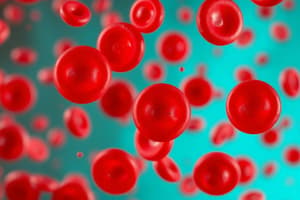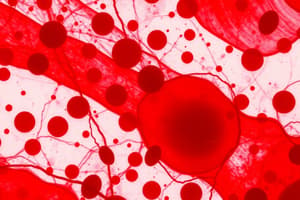Podcast
Questions and Answers
The ______ is the fluid portion of the blood.
The ______ is the fluid portion of the blood.
plasma
In a centrifuged sample of blood, what makes up the buffy coat?
In a centrifuged sample of blood, what makes up the buffy coat?
white blood cells and platelets
Which of the following is NOT a function of blood?
Which of the following is NOT a function of blood?
- Hormone production (correct)
- Transportation of nutrients
- Protection against pathogens
- Regulation of temperature
The main protein in blood plasma is:
The main protein in blood plasma is:
Which plasma constituent is the main contributor to osmotic pressure?
Which plasma constituent is the main contributor to osmotic pressure?
Which of the following is not a formed element of the blood?
Which of the following is not a formed element of the blood?
Choose the statement that is true concerning hemoglobin.
Choose the statement that is true concerning hemoglobin.
In adults, red blood cell production occurs in__________.
In adults, red blood cell production occurs in__________.
Which of the following does not stimulate erythrocyte production?
Which of the following does not stimulate erythrocyte production?
Bilirubin is cleared from the body by:
Bilirubin is cleared from the body by:
Which of the following is correctly matched?
Which of the following is correctly matched?
An abnormal excess of erythrocytes is called__________.
An abnormal excess of erythrocytes is called__________.
The most abundant leukocytes are:
The most abundant leukocytes are:
You observe a large cell with a 'U' shaped nucleus. This cell is most likely a(n):
You observe a large cell with a 'U' shaped nucleus. This cell is most likely a(n):
Platelet formation is regulated by:
Platelet formation is regulated by:
Hemostasis leads to:
Hemostasis leads to:
The first step in hemostasis is:
The first step in hemostasis is:
Which of the formed elements contains hemoglobin and transports respiratory gases?
Which of the formed elements contains hemoglobin and transports respiratory gases?
Which of the following is NOT a functional characteristic of leukocytes?
Which of the following is NOT a functional characteristic of leukocytes?
Which leukocyte functions in phagocytizing bacteria?
Which leukocyte functions in phagocytizing bacteria?
Which of the following represents a difference between extrinsic and intrinsic blood clotting cascades?
Which of the following represents a difference between extrinsic and intrinsic blood clotting cascades?
The enzyme ______ digests fibrin clots.
The enzyme ______ digests fibrin clots.
Which of the following would not lead to a bleeding disorder?
Which of the following would not lead to a bleeding disorder?
A person who lacks agglutinogens A and B would have blood type:
A person who lacks agglutinogens A and B would have blood type:
Which of the following scenarios could result in HDN (hemolytic disease of the newborn)?
Which of the following scenarios could result in HDN (hemolytic disease of the newborn)?
Which of the following is NOT a part of hemostasis?
Which of the following is NOT a part of hemostasis?
What protein involved in coagulation provides the scaffolding for tissue repair?
What protein involved in coagulation provides the scaffolding for tissue repair?
Which of the following does not serve as a site for blood cell production in the developing fetus?
Which of the following does not serve as a site for blood cell production in the developing fetus?
Erythrocytes lack a nucleus.
Erythrocytes lack a nucleus.
All leukocytes are also lymphocytes.
All leukocytes are also lymphocytes.
Which part of the hemoglobin molecule binds carbon dioxide for transport?
Which part of the hemoglobin molecule binds carbon dioxide for transport?
How many oxygen molecules can be transported by one hemoglobin molecule?
How many oxygen molecules can be transported by one hemoglobin molecule?
When oxygen is bound to hemoglobin, what bright red molecule is formed?
When oxygen is bound to hemoglobin, what bright red molecule is formed?
Specifically, what is the production of red blood cells called?
Specifically, what is the production of red blood cells called?
What is a young, anucleate erythrocyte called?
What is a young, anucleate erythrocyte called?
What part of the body does erythropoietin (EPO) target to increase erythropoiesis?
What part of the body does erythropoietin (EPO) target to increase erythropoiesis?
What part of the hemoglobin molecule is recycled to form bile?
What part of the hemoglobin molecule is recycled to form bile?
When a person has an acute bacterial infection, such as meningitis or appendicitis, which type of leukocyte increases in number?
When a person has an acute bacterial infection, such as meningitis or appendicitis, which type of leukocyte increases in number?
Which type of leukocyte is responsible for antibody production?
Which type of leukocyte is responsible for antibody production?
When we take anti-histamines, we are countering the effects of which type of leukocyte?
When we take anti-histamines, we are countering the effects of which type of leukocyte?
Flashcards are hidden until you start studying
Study Notes
Blood Components and Functions
- Plasma is the fluid portion of blood.
- The buffy coat consists of white blood cells and platelets.
- Blood does not produce hormones; its functions include transporting nutrients and gases.
Blood Composition
- The main protein in blood plasma is albumin, crucial for osmotic pressure.
- Antibodies are not considered formed elements of blood.
Hemoglobin and Red Blood Cells
- Hemoglobin comprises four protein chains and four heme groups, allowing oxygen transport.
- In adults, red blood cell production occurs in red bone marrow.
- Conditions like hyperventilation do not stimulate erythrocyte production.
Bilirubin and Anemias
- Bilirubin is removed from the body by the liver.
- Pernicious anemia is linked to vitamin B12 deficiency.
- An excess of erythrocytes results in polycythemia.
Leukocytes
- Neutrophils are the most abundant type of leukocytes and are responsible for phagocytizing bacteria.
- Monocytes can be identified by their U-shaped nucleus.
- Leukocytes possess positive chemotaxis, diapedesis, and amoeboid motion; leukocytosis is not a functional characteristic.
Hemostasis
- Hemostasis is the stoppage of bleeding, initiated by vascular spasm.
- Platelet formation is regulated by thrombopoietin.
- Components of hemostasis do not include vascular relaxation.
- Fibrin provides scaffolding for tissue repair during coagulation.
Blood Types and Rh Factor
- Blood type O is characterized by a lack of agglutinogens A and B.
- Hemolytic disease of the newborn (HDN) can occur if a B- female is pregnant with an AB+ baby.
Coagulation and Clotting
- The enzyme plasmin digests fibrin clots.
- Different blood clotting cascades have varying speeds; one is faster than the other.
Erythropoiesis
- Erythropoiesis refers specifically to the production of red blood cells.
- Erythropoietin (EPO) targets the bone marrow to increase erythropoiesis.
- A young, anucleate erythrocyte is called a reticulocyte.
Hemoglobin and Gas Transport
- One hemoglobin molecule can transport up to four oxygen molecules, forming oxyhemoglobin when bound to oxygen.
- The amino acids of globin in hemoglobin are responsible for binding carbon dioxide.
Immune Response
- In acute bacterial infections, such as meningitis or appendicitis, neutrophils increase in number.
- Lymphocytes are primarily responsible for antibody production.
- Basophils are countered by anti-histamines, which inhibit their functions.
Studying That Suits You
Use AI to generate personalized quizzes and flashcards to suit your learning preferences.




